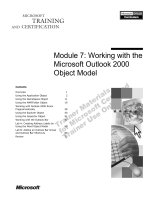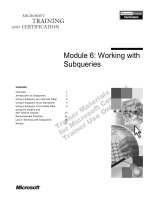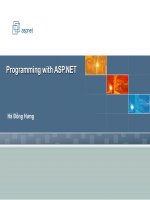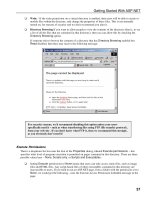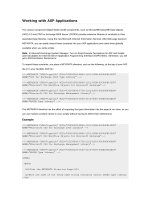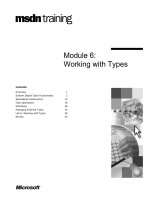Module 1: Working with ASP.NET
Bạn đang xem bản rút gọn của tài liệu. Xem và tải ngay bản đầy đủ của tài liệu tại đây (1.07 MB, 44 trang )
Module 1: Working with
ASP.NET
Contents
Overview
Introducing ASP.NET
Server Controls
1
2
13
Adding ASP.NET Code to a Page
23
Handling Page Events
30
Lab 1: Using ASP.NET to Output Text
35
Review
36
Information in this document is subject to change without notice. The names of companies,
products, people, characters, and/or data mentioned herein are fictitious and are in no way intended
to represent any real individual, company, product, or event, unless otherwise noted. Complying
with all applicable copyright laws is the responsibility of the user. No part of this document may
be reproduced or transmitted in any form or by any means, electronic or mechanical, for any
purpose, without the express written permission of Microsoft Corporation. If, however, your only
means of access is electronic, permission to print one copy is hereby granted.
Microsoft may have patents, patent applications, trademarks, copyrights, or other intellectual
property rights covering subject matter in this document. Except as expressly provided in any
written license agreement from Microsoft, the furnishing of this document does not give you any
license to these patents, trademarks, copyrights, or other intellectual property.
2000 Microsoft Corporation. All rights reserved.
Microsoft, BackOffice, MS-DOS, Windows, Windows NT,
provided by the copy editor. Microsoft is listed first, followed by all other Microsoft trademarks
in alphabetical order. > are either registered trademarks or trademarks of Microsoft Corporation
in the U.S.A. and/or other countries.
Other product and company names mentioned herein may be the trademarks of their respective
owners.
BETA MATERIALS FOR MICROSOFT CERTIFIED TRAINER PREPARATION PURPOSES ONLY
Module 1: Working with ASP.NET
iii
Instructor Notes
Presentation:
120 Minutes
Lab:
30 Minutes
This module provides students with an overview of ASP.NET. Students will
learn about the main features of ASP.NET and discover the differences between
ASP and ASP.NET. They will also learn about server controls and see how to
add server-side script to an ASP.NET page.
In the lab, students will add HTML server controls to an ASP.NET page, and
then add event procedures for the HTML server controls. Students will also add
event procedures to the page.
After completing this module, students will be able to:
!
Identify the main features of ASP.NET.
!
Identify the differences between ASP and ASP.NET.
!
Describe the working model of ASP.NET.
!
Describe the architecture of server controls.
!
Add an HTML server control to a page.
!
Access the properties and methods of server controls in code.
!
Add event handlers for page events.
!
Use the IsPostback property to handle postback forms.
Materials and Preparation
This section provides the materials and preparation tasks that you need to teach
this module.
Required Materials
To teach this module, you need the following materials:
!
Microsoft® PowerPoint® file 2063A_01.ppt
!
Module 1, “ Working with ASP.NET” (2063A_01.doc)
!
Lab, “Using ASP.NET to Output Text” (2063A_L01.doc)
!
Animation: ASP.NET Execution Model (2063A_01A001.swf)
BETA MATERIALS FOR MICROSOFT CERTIFIED TRAINER PREPARATION PURPOSES ONLY
iv
Module 1: Working with ASP.NET
Preparation Tasks
To prepare for this module, you should:
!
Read all of the materials for this module.
!
Complete all the demonstrations.
!
Complete the lab.
!
Go through the animation.
!
Read up material about the .NET framework.
!
Read up material on the various differences between ASP and ASP.NET.
Demonstration
This section provides demonstration procedures that will not fit in the margin
notes or are not appropriate for the student notes.
Adding Server Controls to an ASP.NET Page
! To run this demonstration
1. View the file //localhost/2063/democode/Mod01/server_controls.aspx in
Internet Explorer. This file has a form with an input box, a list box, and a
Submit button. When you fill information in the controls and click Submit,
the information is lost.
2. Edit the page. Add a runat="server" attribute to the 3 controls on the page.
3. View the page in the browser again. View the source of the page to show
the changes that were made. The controls still lose their values.
4. Edi the page and add a runat="server" attribute to the form.
5. View the page in the browser again. View the source of the page to show
the changes that were made. The controls now save their values.
6. Edit the page and change the controls to intrinsic web controls: asp:textbox,
asp:listbox, asp:button.
7. View the page in the browser and show the source of the page.
Adding Code to Controls
! To run this demonstration
The file 2063\DemoCode\Mod01\eventproc.aspx has the completed code
for this demonstration.
1. Open the file //2063/democode/mod01/server_controls.aspx.
2. Change the controls back to HTML server controls and add ID attributes to
the text box and the listbox: txtName and lstTitle.
3. Add a span tag to the bottom of the page:
id="spnGreeting" runat="server">
4. Add an onServerClick attribute to the button that will call the GreetMe
procedure.
BETA MATERIALS FOR MICROSOFT CERTIFIED TRAINER PREPARATION PURPOSES ONLY
Module 1: Working with ASP.NET
v
5. Create a SCRIPT section for server-side code.
<SCRIPT language="VB" runat="Server">
6. Create the GreetMe sub procedure.
Sub GreetMe(s As Object, e As EventArgs)
spnGreeting.InnerHTML = "Hello " & txtName.Value & _
". I see your occupation is " & lstTitle.Value
End Sub
7. View the page in Internet Explorer. When you click the button the values of
the controls are displayed in the span
8. View the source of the page to show that the server-side code is not
included in the page.
Using PostBack Forms
! To run this demonstration
The file 2063\DemoCode\Mod01\postback.aspx has the completed code for
this demonstration.
1. Open the file //2063/democode/mod01/server_controls.aspx.
2. Add a Page_Load event procedure that initializes the text box.
Sub Page_Load(s As Object, e As EventArgs)
txtName.Value = "Enter your name"
End Sub
3. View the page in Internet Explorer. The text box gets loaded with default
text each time.
4. In the Page_Load event procedure, check for IsPostBack and only initialize
the text box the first time the page is loaded.
If Not Page.IsPostBack Then
txtName.Value = "Enter your name"
End If
5. View the page again. Now the initial text is only used the first time.
BETA MATERIALS FOR MICROSOFT CERTIFIED TRAINER PREPARATION PURPOSES ONLY
vi
Module 1: Working with ASP.NET
Multimedia Presentation
This section provides multimedia presentation procedures that do not fit in the
margin notes or are not appropriate for the student notes.
ASP.NET Execution Model
! To present the animation:
Action
Say this
Click First Request
This is what happens when an .aspx is requested for the
first time.
The client sends a request for a page to the ASP.NET
server. (The request is in the HTTP-GET form). In this
animation, the client is requesting the Hello.aspx page.
The server checks to see whether there is an existing
output cache for the requested page, or else if the
requested page is already compiled.
If there is no output cache or compiled code, the source
code for the page is interpreted by a parser, and a
compiler is invoked.
The compiler loads the page and compiles the code into
an intermediate language (IL).
The compiled IL code is used for returning the requested
page to the client.
Click Second Request
When the client requests for the same page the second
time, the server again checks for an existing output cache
or the compiled code.
If the server finds the compiled code, then notice how the
compiler step is omitted and the compiled code is
straightaway used for returning the request.
Click Output Cache
This is the other case, when the server finds the requested
page in the output cache. In this case notice how all the
other steps are bypassed and the requested page is
directly returned from the output cache.
BETA MATERIALS FOR MICROSOFT CERTIFIED TRAINER PREPARATION PURPOSES ONLY
Module 1: Working with ASP.NET
vii
Module Strategy
Use the following strategy to present this module:
!
Introducing ASP.NET
This section provides students an overview of the .NET framework and how
ASP.NET fits in that architecture. The focus of this section is the ASP.NET
architecture; therefore, avoid getting into too many details about the .NET
architecture. The section also talks about the main features of ASP.NET.
Again avoid getting into the details because the following chapters deal with
these features in detail. After discussing the main features of ASP, ask
students to compare it with ASP and come up with a comprehensive list of
differences between ASP and ASP.NET.
ASP
ASP.NET
.asp files
.aspx files
Can only be scripted using VBScript or
JScript
Language independent
Difficult to reuse code
Allows separation of code and content
Need to write code for everything
Provides server controls
Does not support Web services
Includes Web services
This section also includes a demonstration on using VS.NET. This
demonstration gives them the familiarity with the VS.NET interface.
!
Server Controls
ASP.NET introduces the concept of server controls that encapsulate
common tasks and provide a clean programming model. This section
provides students with an overview of server controls and how to use them
in applications. This section also discusses Web controls, but do not get into
the details of Web controls as these are discussed in detail in Module 2,
“Using Web Controls”.
!
Adding ASP.NET Code to a Page
ASP.NET introduces a new way of coding that is very similar to coding in
event-driven languages. In this section, students will learn how to create a
basic ASP.NET page. In addition, this section also includes a topic on the
major differences between Visual Basic 6.0 and Visual Basic.NET Version
7.0.
!
Page Event Life Cycle
This section provides students with information on the life cycle of an
ASP.NET page. It talks about the main events that are involved in a page
life cycle. The section also includes information on the use of IsPostBack
property for postback forms. In the demonstration, show them what will
happen if you do not use the IsPostBack property.
BETA MATERIALS FOR MICROSOFT CERTIFIED TRAINER PREPARATION PURPOSES ONLY
Module 1: Working with ASP.NET
1
Overview
Topic Objective
To provide an overview of
the module topics and
objectives.
Lead-in
In this module, you will learn
about the main features of
ASP.NET, and learn how to
add server-side script to an
ASP.NET page.
!
Introducing ASP.NET
!
Server Controls
!
Adding ASP.NET Code to a Page
!
Handling Page Events
Microsoft's Active Server Pages (ASP) technology is widely used to create
dynamic Web sites and applications. However, ASP has several limitations,
such as the need for redundant and long-winded coding to accomplish simple
goals. To overcome these limitations of ASP, Microsoft has developed a new
technology called ASP.NET, which is a part of the .NET strategy for Web
development. ASP.NET is a unified Web development platform that provides
the services necessary for developers to build enterprise-class Web applications.
In this module you will learn about the main features of ASP.NET and discover
the differences between ASP and ASP.NET. You will also learn about server
controls and see how to add server-side script to an ASP.NET page.
After completing this module, you will be able to:
!
Identify the main features of ASP.NET.
!
Identify the differences between ASP and ASP.NET.
!
Describe the working model of ASP.NET.
!
Describe the architecture of server controls.
!
Add an HTML server control to a page.
!
Access the properties and methods of server controls in code.
!
Add event handlers for page events.
!
Use the IsPostback property to handle postback forms.
BETA MATERIALS FOR MICROSOFT CERTIFIED TRAINER PREPARATION PURPOSES ONLY
2
Module 1: Working with ASP.NET
# Introducing ASP.NET
Topic Objective
To introduce the topics
included in the section.
Lead-in
Before you start using
ASP.NET, you should have
an overview of ASP.NET
and its framework.
!
The .NET Framework
!
ASP.NET Features
!
Animation: The ASP.NET Execution Model
!
Demonstration: Using Visual Studio.NET
In this section, you will read an overview of the .NET Framework and see how
ASP.NET fits in. Next, you will learn about the various features of ASP.NET
and see a working model. You will also learn about the main differences
between ASP and ASP.NET.
BETA MATERIALS FOR MICROSOFT CERTIFIED TRAINER PREPARATION PURPOSES ONLY
Module 1: Working with ASP.NET
3
The .NET Framework
Topic Objective
To provide an overview of
the .NET Framework.
Web Forms
Web Services
Lead-in
ASP.NET is integrated into
the operating system. This
architecture differs
remarkably from earlier
versions of ASP, which were
basically add-ons to the
operating system. ASP.NET
is a part of the .NET
Framework that supports all
applications in Windows.
Win Forms
Data
Base Class Library
Common Language Runtime
The .NET platform provides all the tools and technologies needed to build
distributed Web applications. It exposes a consistent, language-independent
programming model across all tiers of an application, while providing seamless
interoperability with and easy migration from existing technologies.
The .NET platform is composed of several core technologies:
!
The .NET Framework
!
The .NET Building Block Services
!
The .NET Enterprise Servers
!
Microsoft Visual Studio.NET
!
Microsoft Windows.NET
The .NET Framework is a set of technologies that is an integral part of the
Microsoft .NET platform. It provides the basic building blocks for developing
Web applications and services. The .NET Framework includes the following
components:
!
Common Language Runtime
!
Base class library
!
Data
!
Web forms and Web services
!
Win forms
BETA MATERIALS FOR MICROSOFT CERTIFIED TRAINER PREPARATION PURPOSES ONLY
4
Module 1: Working with ASP.NET
Common Language Runtime
The Common Language Runtime provides the programming interface between
the .NET Framework and the programming languages available for the .NET
platform. It simplifies application development, provides a robust and secure
execution environment, supports multiple languages, and simplifies application
deployment and management. The runtime loads and runs code written in any
runtime-aware programming language. Code that targets the runtime is called
managed code. Managed code simply means that there is a defined contract of
cooperation between natively executing code and the runtime itself.
Responsibility for tasks like creating objects, making method calls, and so on is
delegated to the runtime, which enables the runtime to provide additional
services to the executing code.
Base Classes and Libraries
The .NET Framework includes classes that encapsulate data structures, perform
I/O, give you access to information about a loaded class, and provide a way to
invoke security checks. It also includes classes that encapsulate exceptions, and
other helpful functionality such as data access, server side UI projections and
rich GUI generation. The .NET Framework provides both abstract base classes
and class implementations derived from those base classes. You can use these
derived classes "as is" or derive your own classes from them.
The .NET Framework classes are named using a dot-syntax naming scheme that
connotes a naming hierarchy. This technique is used to logically group related
classes together so that they can be searched and referenced more easily. A
grouping of classes is called a namespace. For example, your program can use
classes in the System.Data.SQL namespace to read data from a SQL Server
database.
The root namespace for the .NET Framework is the System namespace.
Data
ADO.NET is the next generation of ActiveX Data Object (ADO) technology.
ADO.NET provides improved support for the disconnected programming
model and also provides rich XML support. ADO was created to provide data
services to traditional client applications that were tightly coupled to the
database; consequently it was not effective for web applications. ADO.NET
was created with the characteristics of web applications in mind.
Web Forms and Web Services
ASP.NET is a programming framework built on the Common Language
Runtime that can be used on a server to build powerful Web applications.
ASP.NET Web forms provide an easy and powerful way to build dynamic user
interfaces. ASP.NET Web services provide the building blocks for constructing
distributed Web-based applications. Web services are based on the industry
standard SOAP specification.
BETA MATERIALS FOR MICROSOFT CERTIFIED TRAINER PREPARATION PURPOSES ONLY
Module 1: Working with ASP.NET
5
Win Forms
For Windows-based applications, the .NET Framework provides the
System.WinForms namespace to create the user interface. You can use
System.WinForms to do rapid application design (RAD). It provides
inheritance in the same client user interface library. You can build components
using inheritance and then aggregate them using a form designer such as
Microsoft Visual Basic.
WinForms will not be covered as part of this class.
BETA MATERIALS FOR MICROSOFT CERTIFIED TRAINER PREPARATION PURPOSES ONLY
6
Module 1: Working with ASP.NET
ASP.NET Features
Topic Objective
To describe the main
features of ASP.NET.
Lead-in
ASP.NET includes many
features that make
ASP.NET a preferred tool
for Web development.
!
Multiple Language Support
!
Increased Performance
!
Classes and Namespaces
!
Server Controls
!
Web Services
ASP.NET is more than just the next version of ASP. It is a totally rearchitected
technology for creating dynamic, Web-based applications. While ASP pages
use the .asp extension, ASP.NET pages use the .aspx extension.
Note Both ASP and ASP.NET pages can be used in the same Web site. Your
existing ASP pages will still work along with your new ASP.NET pages, they
don't have to be converted into ASP.NET pages.
ASP.NET, with a host of new features, allows developers to write cleaner code
that is simple to reuse and share. ASP.NET boosts performance and scalability
by offering access to complied languages. Some of the main features of
ASP.NET are described below.
Multiple Language Support
ASP.NET provides a true language-neutral execution framework for Web
applications.
You can currently use over twenty languages to build .NET applications.
Microsoft has compilers for Visual Basic, C#, C++, and JScript. Third party
vendors are writing .NET compilers for Cobol, Pascal, Perl, and Smalltalk,
among others.
The labs and the sample code in this course will use Visual Basic.
Increased Performance
In ASP.NET, code is compiled. When the page is requested for the first time,
the runtime compiles the code and the page itself and keeps a cached copy of
the compiled result. The cached copy can be used whenever there is another
request for the page. This results in greatly increased performance because after
this first request, the code can run from the much faster compiled version, and
the content on the page doesn’t have to be parsed again.
BETA MATERIALS FOR MICROSOFT CERTIFIED TRAINER PREPARATION PURPOSES ONLY
Module 1: Working with ASP.NET
7
Classes and Namespaces
ASP.NET includes a range of useful classes and namespaces. These class
libraries can make writing Web applications easier. Some of the classes
included with ASP.NET are HtmlAnchor, HtmlControl, and HtmlForm,
which are included within the System.Web.UI.HtmlControls namespace.
For more information on namespaces, see the online Help for the .NET
Framework.
Server Controls
ASP.NET provides several server controls that simplify the task of creating
pages. These server controls encapsulate common tasks that range from
displaying calendars and tables to validating user input. They automatically
maintain their selection state, and expose properties, methods, and events for
server-side code, thereby providing a clean programming model.
You will learn more about using server controls in Module 2: “Using Web
Controls.”
Web Services
A Web service is an application delivered as a service that can be integrated
with other Web services using Internet standards. ASP.NET allows you to use
and create Web services.
For example, a company can assemble an online store using the Microsoft
Passport service to authenticate users, a third-party personalization service to
adapt Web pages to each user's preferences, a credit-card processing service, a
sales tax service, package-tracking services from each shipping company, and
an in-house catalog service that connects to the company's internal inventory
management applications.
Web services provide the building blocks for constructing distributed Webbased applications. ASP.NET files have an .aspx extension, while Web services
have an .asmx extension. The technologies are similar; however, instead of
outputting HTML, a Web service outputs a computer-readable answer to the
input it receives.
You will learn more about Web services in Module 7: “Using Web Services.”
BETA MATERIALS FOR MICROSOFT CERTIFIED TRAINER PREPARATION PURPOSES ONLY
8
Module 1: Working with ASP.NET
ASP.NET Features (Continued)
!
Improved Security
!
Caching
!
Greater Scalability
!
Application State and Session State Management
!
Easy Configuration and Deployment
Improved Security
In ASP, the only type of authentication that you can use is the Windows
authentication, whereas ASP.NET allows different types of login and user
authentication; Windows, Passport, and Cookies.
ASP.NET also enables you to get real account impersonation and have the
server execute code as if the user were present. You can also programmatically
check to see if the user is in a given role and conditionally let him or her
perform certain tasks when given permission.
In addition, creating forms-based authentication in which you can create your
own custom login screen and credential checking is much easier using
ASP.NET.
You will learn more about authentication and creating login forms in Module 7:
“Creating an ASP.NET Web Application.”
Caching
Caching is an extremely important technique for building high-performance,
scalable Web server applications.
ASP.NET offers two caching mechanisms; output caching and ASP.NET
caching that enhance Web application performance.
Output caching is a powerful technique that increases server application
throughput by caching the content generated from dynamic pages. The output
cache is enabled by default and will cache any response that has a valid
expiration or validation policy, and public cache visibility.
BETA MATERIALS FOR MICROSOFT CERTIFIED TRAINER PREPARATION PURPOSES ONLY
Module 1: Working with ASP.NET
9
ASP.NET provides a full-featured cache engine that can be utilized by pages to
store and retrieve arbitrary objects across HTTP requests. The ASP.NET cache
is private to each application and stores objects in memory. The lifetime of the
cache is equivalent to the lifetime of the application. This means that when the
application is restarted, the cache is recreated.
You will learn more about caching in Module 7: “Creating an ASP.NET Web
Application.”
Greater Scalability
Scalability of .NET applications is enhanced because pages are compiled, and
page output can be cached.
In addition, using ASP.NET, session state can now be maintained in a separate
process on a separate machine, or in a database allowing for cross server
sessions. This allows you to add more Web servers as your traffic grows.
Application State and Session State Management
In ASP.NET application state and session state management is extended to
provide a persistent and more scalable environment for storing values relevant
to specific clients and applications. In particular, a user’s session state can now
easily be maintained across a Web farm because it no longer depends on client
side cookies.
You will learn more about maintaining state in Module 7: “Creating an
ASP.NET Web Application.”
Easy Configuration and Deployment
Configuration and deployment are now easier with the use of human-readable
configuration files and DLLs that don't have to be registered.
In ASP.NET, all the configuration details for all Web applications are kept in
human-readable files named config.web. The standard format for the
configuration files is XML, and each application inherits the settings in the
default config.web file.
With .NET, all files that a Web site needs are located under the site's root
folder. DLLs are in the /bin folder, and the config.web file is in the root folder.
To deploy a Web site, all you have to do is copy the site’s root folder using file
copy commands, the Microsoft FrontPage server extensions, or FTP.
You will learn more about configuration options in Module 7: “Creating an
ASP.NET Web Application.”
BETA MATERIALS FOR MICROSOFT CERTIFIED TRAINER PREPARATION PURPOSES ONLY
10
Module 1: Working with ASP.NET
Animation: The ASP.NET Execution Model
Topic Objective
To describe the ASP.NET
execution model.
Lead-in
In this animation, you will
see how ASP.NET pages
are processed on the
server.
Delivery Tip
Run the Macromedia Flash
animation ASP.NET
Execution model.
(2063A_01A001.swf)
In this animation, you will she how ASP.NET pages are processed on the
server. To view the animation, open the 2063A_01A001.swf file from the
Media folder.
For details on how to run
and describe the animation,
see the Multimedia
Presentation section in the
Instructor Notes for this
module.
Delivery Tip
After showing the animation,
summarize the differences
between ASP and
ASP.NET.
BETA MATERIALS FOR MICROSOFT CERTIFIED TRAINER PREPARATION PURPOSES ONLY
Module 1: Working with ASP.NET
11
Demonstration: Using Visual Studio.NET
Topic Objective
To demonstrate how to use
Visual Studio.NET as an
ASP.NET page editor.
Lead-in
In this demonstration, you
will see how Visual
Studio.NET will be used in
this course.
In this demonstration, you will see how to use Visual Studio.NET.
BETA MATERIALS FOR MICROSOFT CERTIFIED TRAINER PREPARATION PURPOSES ONLY
12
Module 1: Working with ASP.NET
Delivery Tip
1. Open Visual Studio.NET
and Create a new Web
Application project.
2. Close all the windows
except the Solution
Explorer.
3. Point out the files that are
added to the project by
default. For most of the
course we will only be
working with ASPX files.
4. An ASPX page is created
by default, WebForm1.aspx,
and is opened in Design
view. Show students how to
switch to HTML view.
5. A code-behind page is
created by default,
WebForm1.vb, for the ASPX
page. Show students how to
delete all the attributes of
the @Page directive except
the Language attribute.
Note: Even though we won't
be using the code-behind
page, it is still there. Show
students how to view the
code-behind page (by
double-clicking on the ASPX
page in design view) and
how to close it (by clicking
the close button).
6. Add an HTML text control
and a button Web control to
the default form to show the
intellisense.
id="txtName"
runat="server">
text="submit"
id="btnSubmit"
onclick="btnSubmit_OnClick
" runat="server"/>
7. Add a script section to an
ASP.NET page, and create
a Click event for the button
that outputs a value in the
text box.
8. Save your work.
9. Either view the page in
the browser or click Start.
BETA MATERIALS FOR MICROSOFT CERTIFIED TRAINER PREPARATION PURPOSES ONLY



